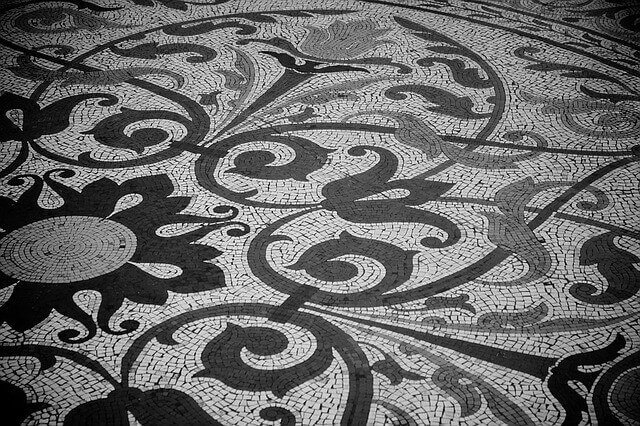Mosaic Flooring
Mosaic flooring is very good in appearance, and best for all types of buildings. This flooring is used for both residential and commercial buildings. In mosaic flooring, the top surface exhibits different designs of marble pieces or broken tile pieces.
Pieces of marble and tiles used for this floor may be in different colors and sizes, depending on what type is required for a particular building. The process of cutting or breaking tiles or marble is very specialized work. The tiles should be broken to the shape of a wedge, with a polished or glazed side on the broad face.

Read Also: Different Types of Flooring
Method of Construction
In the case of mosaic flooring construction, at first, a hard sub-grade of lime concrete is prepared around 100 to 150 mm thick. Then, A layer of cement concrete is laid over the subgrade, and the thickness of this layer is kept around 25 mm to 40 mm. The surface of this layer is then cleaned properly and wetted by sprinkling water over it.
After properly completing the above processes, a layer of lime surkhi mortar or cement mortar is laid over the concrete base. And the thickness of this layer is around 40 mm to 60 mm. This mortar should be spread on a small area at a time so that it is possible to finish the flooring of this area before the mortar becomes dry and hard.
Now on this lime surkhi mortar layer, an another layer of paste or cementing material( 2 slaked lime :1 powdered marble: 1 pozzolana ) is laid, and the thickness of this layer is around 3 mm. After that, broken tiles or marble pieces are set in desired design and pattern.
When fragments of broken tiles or pieces of marble are set in the desired pattern, the dry cement is sprinkled over the top and the surface is then either gently rolled with a light roller or a large flat piece of wood, is placed on the surface and gently hammered on the top.
While rolling, water is sprinkled and cement works up between the pieces of tiles or marble. After rolling and when pieces are well set, the extra cement is wiped clean with sawdust.
The surface is left for a day to dry, and then it is polished by rubbing with a pumice stone to get a smooth and polished surface. At last, the finished surface is allowed to dry for one or two weeks before use.
Read More: